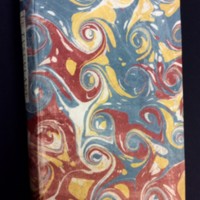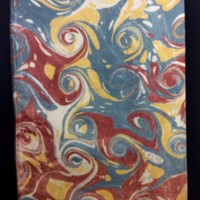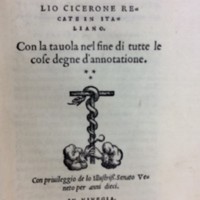Marcus Tullius, Le Tusculane di M. Tullio Cicerone recate
Dublin Core
Title
Marcus Tullius, Le Tusculane di M. Tullio Cicerone recate
Description
English
This item offers us a glance at marbled paper very typical of the 18th century, with its traditional choice of colours and a design typical of the era; many similar examples are to be found in the collection. The Encyclopedie by Diderot and D’Alembert goes into great detail as to the necessary steps of creating colours and designs for marbled papers. What sets this particular example apart and why it has been chosen for display is the fact that the marbled paper is not found where typically expected, that is, as interior “endpapers” within the book. It is, in fact, covering and thus forming the exterior of the book’s binding.
Français
On trouve ici un exemple typique de papier marbré du XVIIIe siècle. Les couleurs traditionnelles et le motif sont très populaires à cette époque et on trouve une multitude de papiers décorés similaires dans la collection. D’ailleurs l’Encyclopédie de Diderot et d’Alembert explique en détail les étapes nécessaires à la création des couleurs et du motif. L’originalité ici vient du fait que ce papier est utilisé non pas sur les plats intérieurs, mais bien comme couverture de la reliure.
This item offers us a glance at marbled paper very typical of the 18th century, with its traditional choice of colours and a design typical of the era; many similar examples are to be found in the collection. The Encyclopedie by Diderot and D’Alembert goes into great detail as to the necessary steps of creating colours and designs for marbled papers. What sets this particular example apart and why it has been chosen for display is the fact that the marbled paper is not found where typically expected, that is, as interior “endpapers” within the book. It is, in fact, covering and thus forming the exterior of the book’s binding.
Français
On trouve ici un exemple typique de papier marbré du XVIIIe siècle. Les couleurs traditionnelles et le motif sont très populaires à cette époque et on trouve une multitude de papiers décorés similaires dans la collection. D’ailleurs l’Encyclopédie de Diderot et d’Alembert explique en détail les étapes nécessaires à la création des couleurs et du motif. L’originalité ici vient du fait que ce papier est utilisé non pas sur les plats intérieurs, mais bien comme couverture de la reliure.
Creator
Cicero
Source
Archives and Special Collections, University of Ottawa [PA6314 T8 F38 1544]/Archives et collections spéciales, Université d'Ottawa [PA6314 T8 F38 1544]
Publisher
Vinegia, Apresso Vicenzo Vaugris a'l segno d'Erasmo, MDXLIIII
Date
1544
Rights
Archives and Special Collections, University of Ottawa/Archives et collections spéciales, Université d'Ottawa
Format
Book/Livre
Language
Italian/Italien
Type
Text/Texte
Identifier
ARSC_PM_PA6314 T8 F38 1544
Collection
Citation
Cicero, “Marcus Tullius, Le Tusculane di M. Tullio Cicerone recate,” Archives et collections spéciales, Bibliothèque d'Ottawa, accessed December 13, 2025, http://omeka.uottawa.ca/arcs/items/show/50.



